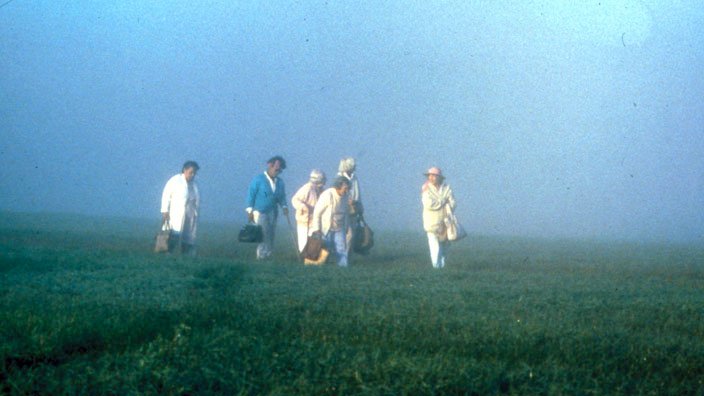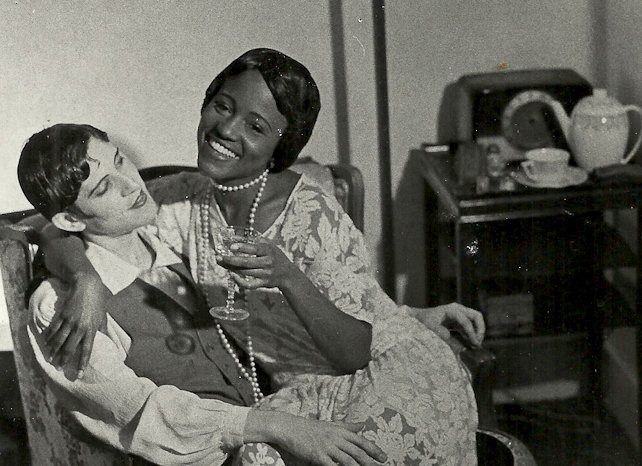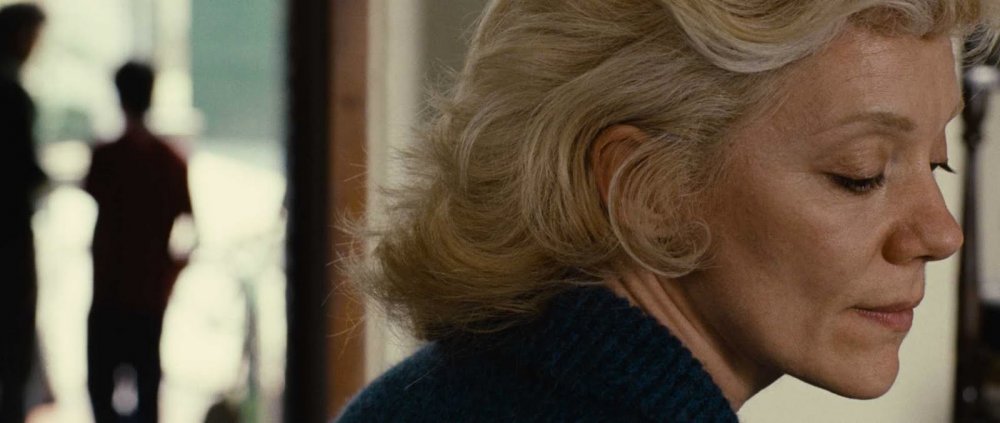
A Question of Silence (1982)
The criteria for the films in this list are that they are fictional, made by women and feature female protagonists. Finally, all are made in the spirit of liberation. There are many notable films that provide stark and uncompromising images of women living under patriarchal law and male order, among them Barbara Loden’s
Wanda (USA 1971) and Chantal Akerman’s
Jeanne Dielman, 23, Quai du Commerce, 1080 Bruxelles (1975). I wanted, however, to focus on films that provide images of celebration rather than endurance. Films directed by men, in spite of there being some key titles, have been excluded as female filmmakers are too often absent from this type of list.
Availability for feminist classics is scarce. Feminist films are frequently ‘disappeared’ from film culture. Where, for example, are the films of
Stephanie Rothman? Why can’t we get Julie Dash’s
Daughters of the Dust (1991) on DVD?
Other filmmakers that should be mentioned in the context of feminist filmmaking are the Hollywood directors, who in the late 1970s and early 1980s were part of a new wave of feminist film, among them
Joan Micklin Silver (Between the Lines, 1977),
Claudia Weill(Girlfriends, 1978) and
Susan Seidelman (Smithereens, 1982 and Desperately Seeking Susan, 1985).
The directors working in Britain today must also be acknowledged. Their films provide examples of interesting and often inspirational female characters. Filmmakers like
Gurinder Chadha,
Andrea Arnold and
Carol Morley are in their own ways keeping the tradition alive.
The Seashell and the Clergyman (1928)
Director Germaine Dulac

The Seashell and the Clergyman (1928)
It is a generally unrecognised fact that women played a significant role in the development of filmmaking. Like the Suffragettes, whose marches are recorded on early 20th century newsreel, women were activists behind the camera as well.
Germaine Dulac was involved in the avant garde in Paris in the 1920s. Both
The Smiling Madame Beudet (1922) and
The Seashell and the Clergyman are important early examples of radical experimental feminist filmmaking, and provide an antidote to the art made by the surrealist brotherhood. The latter film, an interpretation of Anton Artaud’s book of the same name, is a visually imaginative critique of patriarchy – state and church – and of male sexuality. On its premiere, the surrealists greeted it with noisy derision, calling Dulac “une vache”.
The film features a central female character, who is deeply subversive and resists the power of the king and the desire of the priest. In one memorable sequence she holds aloft a burning bra – prefiguring a much later activism! The film was banned by the British Board of Film Censors in 1927, who wrote: “this film is so cryptic as to be almost meaningless. If there is a meaning, it is doubtless objectionable.”
Marianne and Juliane (1981)
Director Margarethe von Trotta

Marianne and Juliane (1981)
Margarethe von Trotta started making films as part of the New German Cinema wave in the 1970s, that typically dealt with the repression of the state. Her early films explored the psychology of relationships between women, often sisters or very close friends. In
Marianne and Juliane (aka The German Sisters) von Trotta explores the twin themes of state repression and family guilt.
The film is loosely based on real-life sisters Christiane and Gudrun Ensslin – the latter a key member of the Red Army Faction. The film documents in a series of flashbacks the childhood and the changing bond between the two women, one a journalist, the other a street fighter. Von Trotta’s film provides a unique female perspective on a violent period in West Germany’s postwar history, as well as representing the contribution of female militancy.
A Question of Silence (1982)
Director Marleen Gorris

A Question of Silence (1982)
The premise of this Dutch radical feminist film is that men and women inhabit different universes. It is a female conspiracy film built around a central incident in which three women, a mute housewife, a garrulous cafe worker and a business secretary, unite to batter a male shop assistant to death.
While the women await trial, a female psychiatrist is employed to assess their sanity. The film charts the psychiatrist’s gradual journey from complete incomprehension to knowing identification with the three defendants. In the film’s denouement, which takes place in court, the psychiatrist, the female witnesses and the defendants themselves, spontaneously join together in hysterical laughter, which results in them being ordered out of the courtroom. As they are led out of court still laughing manically, representatives of the male judiciary look on bewildered. At the time of its release, audiences were similarly divided along gender lines: women understood it, men hated it!
Born in Flames (1983)
Director Lizzie Borden
Made on a shoestring budget,
Lizzie Borden’s film weaves a loose and freewheeling narrative that incorporates home movies of local demos and pickets, video reconstruction and TV newsreels, to provide a heady flavour of activism in a futurist New York City. This patchwork of low budget footage, matched with the pumping soundtrack coming from women’s pirate radio stations, and the fact that the cast are mostly non-actors, gives the film a raw edge, as we follow a diverse range of female characters all struggling to survive.
When Adelaide Norris, a black lesbian feminist and trade unionist, dies in police custody, the women, individually and in groups, get together to fight back against state oppression. Their organisations and the creativity of their militancy is at the heart of the film’s concerns, as it pays tribute to the pivotal contribution of women of colour in the political struggle: “Black women, be ready. White women, get ready. Red women, stay ready.”
The Gold Diggers (1983)
Director Sally Potter
Sally Potter’s film mixes a range of genres including the avant-garde, arthouse and agitprop in a rigorous look at the power of patriarchy and the relationship between capitalist economics and women as icons and exchange objects. The film is also concerned with the power of the image, mediated through an examination of cinema itself – its history and its ideological power.
The film was shot in stunning high contrast black and white and filmed on location in Iceland. Its stark images reference moments from early cinema, such as the silent shorts of
D.W. Griffiths and the Hollywood musical
Gold Diggers of 1933, from which it derives its name. Additionally the film incorporates aspects of feminist film theory, including notions of the male gaze. The relationship between the two female protagonists, one black and the other white, highlights the complex relationship between gender and race, which in turn throws into relief the relationship between capitalism and colonialism.
The film is notable for its all-female crew. The three screenwriters,
Sally Potter,
Rose English and
Lindsay Cooper, were also responsible for the artistic elements – dance, art design and music, respectively.
Vagabond (1985)
Director Agnès Varda
The frozen body of a young woman is discovered in a ditch in the middle of the French countryside. This opening enigma introduces an investigative narrative that presents a series of vignettes – flashbacks of people during their encounters with the young woman, Mona (
Sandrine Bonnaire), in the last few weeks of her life. Shot in a sparse rural landscape, the film explores people’s attitudes towards a vagrant who is female. From most of the men she experiences sexism, whereas the women are generally more sympathetic. Some characters actually envy her freedom.
Varda’s films always feature strong women, but in creating a female character who chooses to live outside society, she has produced her most revolutionary character. Mona’s role actually represents gender trespass, because the kind of freedom she claims is only ever the province of the male. In this radical reversal, the traditional image of the female is liberated from the patriarchal order.
The Company of Strangers (1990)
Director Cynthia Scott

The Company of Strangers (1990)
This film uses the true-life stories of its all-female cast to construct its narrative, which revolves around a group of senior citizens thrown together for a coach trip. When their coach breaks down in the middle of the Quebec countryside, they are forced to get to know one another and work together in order to survive. The women are all over 70, apart from the younger black coach driver, and come from an assortment of cultures and backgrounds, including a Native American woman, a middle-class widow, an out lesbian and a nun. Discussions between them, many of which are improvised and based on the actors’ own experiences, deal with issues such as ageing, racism, celibacy, love and marriage.
The spirit of the women, who endure exhaustion, extreme heat and hunger, is truly inspirational. This is a feel-good movie that focuses on a female group sorely neglected in cinema – namely, older women.
The Watermelon Woman (1996)
Director Cheryl Dunye

The Watermelon Woman (1996)
Like
Cheryl Dunye’s previous shorts,
The Watermelon Woman is a combination of real-life and fictional recreation, with some of the characters, like Cheryl and her mother, playing themselves and others acting. Her term for this original genre is ‘Dunyementary’.
The narrative typically revolves around Cheryl, the filmmaker, who is on a quest to find the mythical black female character she has seen in films made in the 1930s, (the so-called Watermelon Woman). Cheryl gradually uncovers the presence of a number of African American Hollywood actors, hidden from history (some of whom the film constructs, some of whom are authentic).
The film is both personal, about Cheryl, and political, about the lives and contribution of black people to cinema. The merging of the real and the imagined, the mixing of persona and performance, the combination of genuine archival material and recreated archival footage all function to throw into relief the philosophical problem of representing the real, and the political importance of reconstructing a history that has been neglected.
The Day I Became a Woman (2000)
Director Marzieh Meshkini

The Day I Became a Woman (2000)
Marzieh Meshkini is one of a number of women directors working in contemporary Iranian cinema. The film is structured in three episodes and each segment tells the story of a female at a different stage of her life. First, Hava, who is approaching her ninth birthday – traditionally the moment she must leave childhood behind and stop playing with boys. The second, Ahoo, is a young wife who is a contestant in a woman’s bicycle race, against her family’s wishes. Finally, Hoora is an old woman who goes on the ultimate shopping spree to buy all the things she has never had. Each vignette shows the disappointment and thwarted desire that women experience.
The setting of Kish, an island in the Persian Gulf, with its vast stretches of sand, provides the film with its visual impact. The imagery in the second and third episodes becomes surreal. The young woman on a bicycle, one among hundreds of women clad from head to toe in black, speeding along the coastal road in an empty countryside, with her husband’s family galloping after her on horseback, is unforgettable, as is the image of the old woman with her purchases – the entire contents of a new home, floating on a raft out to sea.
The Headless Woman (2008)
Director Lucrecia Martel

The Headless Woman (2008)
On one level this is the story of a middle-aged, middle-class woman, who has a car accident, suffers concussion, and later worries that she has hit, maybe even killed a young boy. On another level it is a political parable, dealing with the question of the ‘disappeared’: the thousands of trade unionists, activists and left-wing students who went missing under Argentina’s 1970s dictatorship.
The film is structured so that the audience shares the confusion and frustration of the central character, Vero (
María Onetto). Her husband, realising that she may be responsible for the death of an indigenous boy, covers up the evidence, leaving her in the dark. The film links the disempowered position of women within the family to that of racism within the society.
Much of the action is filmed through glass, or in the rain, or slightly out of frame, keeping the audience, like Vero, in the dark. The film systematically withholds evidence – the audience, like the central character, never finally knows for sure what has happened. As with the disappearance of evidence in the case of those murdered during the dictatorship, truth can only be grasped by piecing together what remains in the form of traces and half-truths. This is all Vero is left with, but in the process of trying to uncover what she has done, she finally comes to an understanding of the mechanisms of power and control in the world.























